Synthesis, Docking, 3-D-Qsar, and Biological Assays of Novel Indole Derivatives Targeting Serotonin Transporter, Dopamine D2 Receptor, and Mao-A Enzyme: In the Pursuit for Potential Multitarget Directed Ligands
Abstract
:1. Introduction
2. Results and Discussion
2.1. Chemistry Series I
2,3-Dihydro-benzo[b][1,4] oxazin-4-yl)-2-{4-[3-(1H-3-indolyl)-propyl]-1-piperazinyl} ethanamide derivatives 7a–o
2.2. Chemistry Series II
(2-{4-[3-(1H-Indol-3-yl)-propyl]-1-piperazinyl}-acetylamine)-N-(2-morpholin-4-yl-ethyl)-fluorinated benzamides
2.3. Pharmacology Series I
2.4. Docking Simulation Series I
2.4.1. hSERT
2.4.2. D2 Receptor
2.5. Pharmacology Series II
2.6. Docking Simulation Series II
2.7. 3-D-QSAR Study
3. Materials and Methods
3.1. General Methods
3.1.1. General Procedure for the Synthesis of [4-[2-(3,4-Dihydro-2H-benzo[b][1,4]oxazin-4-yl)-2-oxo-ethyl]-piperazine-1-yl] tert-butylcarbamate Derivatives 5a–c
[4-[2-(3,4-Dihydro-2H-benzo[b][1,4]oxazin-4-yl)-2-oxo-ethyl]-1-piperazinyl] tert-butylcarbamate (5a) as a Model
[4-[2-(7-Fluoro-2,3-dihydro-benzo[b][1,4]oxazin-4-yl)-2-oxo-ethyl]-1-piperazinyl] tert-butylcarbamate (5b)
[4-[2-(6-Fluoro-2,3-dihydro-benzo[b][1,4]oxazin-4-yl)-2-oxo-ethyl]-1-piperazinyl] tert-butylcarbamate (5c)
3.1.2. General Procedure for the Synthesis of 1-(2,3-dihydro-benzo[1,4]oxazin-4-yl)-2-piperazin-1-yl-ethanamide Derivatives 6a–c
Synthesis of 1-(2,3-Dihydro-benzo[b][1,4]oxazin-4-yl)-2-(1-piperazinyl) ethanamide (6a) as a Model
1-(7-Fluoro-2,3-dihydro-benzo[b][1,4]oxazin-4-yl)-2-(1-piperazinyl) ethanamide (6b)
1-(6-Fluoro-2,3-dihydro-benzo[b][1,4]oxazin-4-yl)-2-(1-piperazinyl) ethanamide (6c)
3.1.3. General Procedure for the Synthesis of 2,3-dihydro-benzo[b][1,4] oxazin-4-yl)-2-{4-[3-(1H-3-indolyl)-propyl]-1-piperazinyl} ethanamide Derivatives 7a–c, 7g–i, and 7m–o. Method 1
1-(2,3-Dihydro-benzo[b][1,4]oxazin-4-yl)-2-{4-[3-(1H-3-indolyl)-propyl]-1-piperazinyl} ethanamide (7a) as a Model
1-(7-Fluoro-2,3-dihydro-benzo[b][1,4]oxazin-4-yl)-2-{4-[3-(1H-3-indolyl)-propyl]-1-piperazinyl} ethanamide (7b)
1-(6-Fluoro-2,3-dihydro-benzo[b][1,4]oxazin-4-yl)-2-{4-[3-(1H-3-indolyl)-propyl]-1-piperazinyl} ethanamide (7c)
1-(2,3-Dihydro-benzo[b][1,4]oxazin-4-yl)-2-{4-[3-(5-fluoro-1H-3-indolyl)-propyl]-1-piperazinyl} ethanamide (7g)
1-(7-Fluoro-2,3-dihydro-benzo[b][1,4]oxazin-4-yl)-2-{4-[3-(5-fluoro-1H-3-indolyl)-propyl]-1-piperazinyl} ethanamide (7h)
1-(6-Fluoro-2,3-dihydro-benzo[b][1,4]oxazin-4-yl)-2-{4-[3-(5-fluoro-1H-3-indolyl)-propyl]-1-piperazinyl} ethanamide (7i)
1-(2,3-Dihydro-benzo[b][1,4]oxazin-4-yl)-2-{4-[3-(5-bromo-1H-3-indolyl)-propyl]-1-piperazinyl} ethanamide (7m)
1-(7-Fluoro-2,3-dihydro-benzo[b][1,4]oxazin-4-yl)-2-{4-[3-(5-bromo-1H-3-indolyl)-propyl]-1-piperazinyl} ethanamide (7n)
1-(6-Fluoro-2,3-dihydro-benzo[b][1,4]oxazin-4-yl)-2-{4-[3-(5-bromo-1H-3-indolyl)-propyl]-1-piperazinyl} ethanamide (7o)
3.1.4. General procedure for the synthesis of 2,3-Dihydro-benzo[1,4]oxazin-4-yl)-2-{4-[3-(1H-3-indolyl)-propyl]-1-piperazinyl} ethanamides 7d–f and 7j–l. Method 2
Synthesis of 1-(6-Chloro-2,3-dihydro-benzo[b][1,4]oxazin-4-yl)-2-{4-[3-(1H-3-indolyl)-propyl]-1- piperazinyl} ethanamide. Compound (7d) as a Model
1-(6-Bromo-2,3-dihydro-benzo[b][1,4]oxazin-4-yl)-2-{4-[3-(1H-3-indolyl)-propyl]-1-piperazinyl} ethanamide (7e)
1-(6-Methoxy-2,3-dihydro-benzo[b][1,4]oxazin-4-yl)-2-{4-[3-(1H-3-indolyl)-propyl]-1-piperazinyl} ethanamide (7f)
1-(6-Chloro-2,3-dihydro-benzo[b][1,4]oxazin-4-yl)-2-{4-[3-(5-fluoro-1H-3-indolyl)-propyl]-1-piperazinyl} ethanamide (7j)
1-(6-Bromo-2,3-dihydro-benzo[b][1,4]oxazin-4-yl)-2-{4-[3-(5-fluoro-1H-3-indolyl)-propyl]-1-piperazinyl} ethanamide (7k)
1-(6-Methoxy-2,3-dihydro-benzo[b][1,4]oxazin-4-yl)-2-{4-[3-(5-fluoro-1H-3-indolyl)-propyl]-1-piperazinyl} ethanamide (7l)
3.1.5. General Procedure for the Synthesis of N-(2-morpholin-4-yl-ethyl)-benzamides nitro-fluorinated Derivatives 10a–d
4-Fluoro-N-(2-morpholin-4-yl-ethyl)-2-nitro-benzamide (10a) as a Model
4-Fluoro-N-(2-morpholin-4-yl-ethyl)-3-nitro-benzamide (10b)
5-Fluoro-N-(2-morpholin-4-yl-ethyl)-2-nitro-benzamide (10c)
2-Fluor-N-(2-morpholin-4-yl-ethyl)-5-nitro-benzamide (10d)
3.1.6. General Procedure for the Synthesis of N-(2-morpholin-4-yl-ethyl)-benzamides amino-fluorinated Derivatives 11a–d
2-Amino-N-(2-morpholin-4-yl-ethyl)-4-fluoro-benzamide (11a) as a Model
3-Amino-N-(2-morpholin-4-yl-ethyl)-4-fluoro-benzamide (11b)
2-Amino-N-(2-morpholin-4-yl-ethyl)-5-fluoro-benzamide (11c)
5-Amino-N-(2-morpholin-4-yl-ethyl)-2-fluoro-benzamide (11d)
3.1.7. General Procedure for the Synthesis of (2-Chloro-acetylamino)-N-(2-morpholin-4-yl-ethyl) fluorinated Benzamides Derivatives 12a–d
2-(2-Chloro-acetylamino)-4-fluoro-N-(2-morpholin-4-yl-ethyl)-benzamide (12a) as a Model
3-(2-Chloro-acetylamino)-4-fluoro-N-(2-morpholin-4-yl-ethyl)-benzamide (12b)
2-(2-Chloro-acetylamino)-5-fluoro-N-(2-morpholin-4-yl-ethyl)-benzamide (12c)
5-(2-Chloro-acetylamino)-2-fluoro-N-(2-morpholin-4-yl-ethyl)-benzamide (12d)
3.1.8. General Procedure for the Synthesis of (2-{4-[3-(1H-3-indolyl)-propyl]-1-piperazinyl}-acetylamino)-N-(2-morpholin-4-yl-ethyl)-fluorinated Benzamides Derivatives 13a–l
4-Fluoro-2-(2-{4-[3-(5-fluor-1H-3-indolyl)-propyl]-1-piperazinyl}-acetylamino)-N-(2-morpholin-4-yl-ethyl) Benzamide (13a) as a Model
4-Fluoro-3-(2-{4-[3-(5-fluor-1H-3-indolyl)-propyl]-1-piperazinyl}-acetylamino)-N-(2-morpholin-4-yl-ethyl) Benzamide (13b)
2-Fluoro-5-(2-{4-[3-(5-fluor-1H-3-indolyl)-propyl]-1-piperazinyl}-acetylamino)-N-(2-morpholin-4-yl-ethyl) Benzamide (13c)
5-Fluoro-2-(2-{4-[3-(5-fluoro-1H-3-indolyl)-propyl]-1-piperazinyl}-acetylamino)-N-(2-morpholin-4-yl-ethyl) Benzamide (13d)
4-Fluoro-2-(2-{4-[3-(5-bromo-1H-3-indolyl)-propyl]-1-piperazinyl}-acetylamino)-N-(2-morpholin-4-yl-ethyl) Benzamide (13e)
4-Fluoro-3-(2-{4-[3-(5-bromo-1H-3-indolyl)-propyl]-1-piperazinyl}-acetylamino)-N-(2-morpholin-4-yl-ethyl) Benzamide (13f)
2-Fluoro-5-(2-{4-[3-(5-bromo-1H-3-indolyl)-propyl]-1-piperazinyl}-acetylamino)-N-(2-morpholin-4-yl-ethyl) Benzamide (13g)
5-Fluoro-2-(2-{4-[3-(5-bromo-1H-3-indolyl)-propyl]-1-piperazinyl}-acetylamino)-N-(2-morpholin-4-yl-ethyl) Benzamide (13h)
4-Fluoro-2-(2-{4-[3-(1H-3-indolyl)-propyl]-1-piperazinyl}-acetylamino)-N-(2-morpholin-4-yl-ethyl) Benzamide (13i)
4-Fluoro-3-(2-{4-[3-(1H-3-indolyl)-propyl]-1-piperazinyl}-acetylamino)-N-(2-morpholin-4-yl-ethyl) Benzamide (13j)
2-Fluoro-5-(2-{4-[3-(1H-3-indolyl)-propyl]-1-piperazinyl}-acetylamino)-N-(2-morpholin-4-yl-ethyl) Benzamide (13k)
5-Fluoro-2-(2-{4-[3-(1H-3-indolyl)-propyl]-1-piperazinyl}-acetylamino)-N-(2-morpholin-4-yl-ethyl) Benzamide (13l)
3.2. Biological Assay
3.2.1. Reagents
3.2.2. SERT Binding
3.2.3. D2 Receptor Binding
3.2.4. MAO-A Inhibition
3.2.5. Molecular Docking
3.2.6. QSAR Methods
4. Conclusions
Supplementary Materials
Author Contributions
Funding
Acknowledgments
Conflicts of Interest
References
- Depression Fact Sheet; World Health Organization (WHO): Geneva, Switzerland, 2020; Available online: https://www.who.int/news-room/fact-sheets/detail/depression (accessed on 10 September 2020).
- Miller, N.; Perich, T.; Meade, T. Depression, mania and self-reported creativity in bipolar disorder. Psychiatry Res. 2019, 276, 129–133. [Google Scholar] [CrossRef] [PubMed]
- Watters, A.J.; Carpenter, J.S.; Harris, A.W.F.; Korgaonkar, M.S.; Williams, L.M. Characterizing neurocognitive markers of familial risk for depression using multi-modal imaging, behavioral and self-report measures. J. Affect. Disord. 2019, 253, 336–342. [Google Scholar] [CrossRef] [PubMed]
- McIntosh, A.M.; Sullivan, P.F.; Lewis, C.M. Uncovering the Genetic Architecture of Major Depression. Neuron 2019, 102, 91–103. [Google Scholar] [CrossRef]
- Coretti, S.; Rumi, F.; Cicchetti, A. The Social Cost of Major Depression. A Systematic Review. Rev. Eur. Stud. 2019, 11, 73. [Google Scholar] [CrossRef]
- Collins, P.Y.; Patel, V.; Joestl, S.S.; March, D.; Insel, T.R.; Daar, A.S.; Bordin, I.A.; Costello, E.J.; Durkin, M.; Fairburn, C.; et al. Grand challenges in global mental health. Nature 2011, 475, 27–30. [Google Scholar] [CrossRef]
- Hirschfeld, R.M. History and evolution of the monoamine hypothesis of depression. J. Clin. Psychiatry 2000, 61 (Suppl. 6), 4–6. [Google Scholar]
- Berton, O.; Nestler, E.J. New approaches to antidepressant drug discovery: Beyond monoamines. Nat. Rev. Neurosci. 2006, 7, 137–151. [Google Scholar] [CrossRef]
- Hasler, G. Pathophysiology of depression: Do we have any solid evidence of interest to clinicians? World Psychiatry 2010, 9, 155–161. [Google Scholar] [CrossRef] [Green Version]
- Lazar, M.A.; McIntyre, R.S. Chapter 34 Novel Therapeutic Targets for Major Depressive Disorder. In Neurobiology of Depression; Academic Press: London, UK, 2019; pp. 383–400. [Google Scholar]
- Hendrie, C.; Pickles, A. The failure of the antidepressant drug discovery process is systemic. J. Psychopharmacol. 2013, 27, 407–416. [Google Scholar] [CrossRef]
- Brummelte, S.; Mc Glanaghy, E.; Bonnin, A.; Oberlander, T.F. Developmental changes in serotonin signaling: Implications for early brain function, behavior and adaptation. Neuroscience 2017, 342, 212–231. [Google Scholar] [CrossRef] [Green Version]
- David, D.J.; Gardier, A.M. The pharmacological basis of the serotonin system: Application to antidepressant response. L’Encephale 2016, 42, 255–263. [Google Scholar] [CrossRef] [PubMed]
- Javelot, H. Psychopharmacology of anxiety and depression: Historical aspects, current treatments and perspectives. Ann. Pharm. Fr. 2016, 74, 93–118. [Google Scholar] [CrossRef] [PubMed]
- Daut, R.A.; Fonken, L.K. Circadian regulation of depression: A role for serotonin. Front. Neuroendocrinol. 2019, 54, 100746. [Google Scholar] [CrossRef] [PubMed]
- Hillhouse, T.M.; Porter, J.H. A brief history of the development of antidepressant drugs: From monoamines to glutamate. Exp. Clin. Psychopharmacol. 2015, 23, 1–21. [Google Scholar] [CrossRef]
- Milelli, A.; Turrini, E.; Catanzaro, E.; Maffei, F.; Fimognari, C. Perspectives in Designing Multifunctional Molecules in Antipsychotic Drug Discovery. Drug Dev. Res. 2016, 77, 437–443. [Google Scholar] [CrossRef]
- Mendonça Júnior, F.J.B.; Scotti, L.; Ishiki, H.; Botelho, S.P.S.; Da Silva, M.S.; Scotti, M.T. Benzo- and thienobenzo- diazepines: Multi-target drugs for CNS disorders. Mini Rev. Med. Chem. 2015, 15, 630–647. [Google Scholar] [CrossRef]
- Reyes-Parada, M.; Iturriaga-Vasquez, P. The development of novel polypharmacological agents targeting the multiple binding sites of nicotinic acetylcholine receptors. Expert Opin. Drug Discov. 2016, 11, 969–981. [Google Scholar] [CrossRef]
- Subbaiah, M.A.M. Triple Reuptake Inhibitors as Potential Therapeutics for Depression and Other Disorders: Design Paradigm and Developmental Challenges. J. Med. Chem. 2018, 61, 2133–2165. [Google Scholar] [CrossRef]
- Juárez Olguín, H.; Calderón Guzmán, D.; Hernández García, E.; Barragán Mejía, G. The Role of Dopamine and Its Dysfunction as a Consequence of Oxidative Stress. Oxid. Med. Cell. Longev. 2016, 2016, 9730467. [Google Scholar] [CrossRef] [Green Version]
- Berridge, K.C. The debate over dopamine’s role in reward: The case for incentive salience. Psychopharmacology 2007, 191, 391–431. [Google Scholar] [CrossRef]
- Wise, R.A. Dopamine, learning and motivation. Nat. Rev. Neurosci. 2004, 5, 483–494. [Google Scholar] [CrossRef] [PubMed]
- Belujon, P.; Grace, A.A. Dopamine System Dysregulation in Major Depressive Disorders. Int. J. Neuropsychopharmacol. 2017, 20, 1036–1046. [Google Scholar] [CrossRef] [PubMed] [Green Version]
- Brisch, R.; Saniotis, A.; Wolf, R.; Bielau, H.; Bernstein, H.-G.; Steiner, J.; Bogerts, B.; Braun, K.; Jankowski, Z.; Kumaratilake, J.; et al. The Role of Dopamine in Schizophrenia from a Neurobiological and Evolutionary Perspective: Old Fashioned, but Still in Vogue. Front. Psychiatry 2014, 5, 47. [Google Scholar] [CrossRef] [PubMed]
- Meder, D.; Herz, D.M.; Rowe, J.B.; Lehéricy, S.; Siebner, H.R. The role of dopamine in the brain—Lessons learned from Parkinson’s disease. Neuroimage 2019, 190, 79–93. [Google Scholar] [CrossRef] [PubMed]
- Dunlop, B.W.; Nemeroff, C.B. The Role of Dopamine in the Pathophysiology of Depression. Arch. Gen. Psychiatry 2007, 64, 327–337. [Google Scholar] [CrossRef]
- Gold, M.S.; Blum, K.; Febo, M.; Baron, D.; Modestino, E.J.; Elman, I.; Badgaiyan, R.D. Molecular role of dopamine in anhedonia linked to reward deficiency syndrome (RDS) and anti- reward systems. Front. Biosci. (Schol. Ed.) 2018, 10, 309–325. [Google Scholar] [CrossRef] [Green Version]
- Cramer, A.O.J.; van Borkulo, C.D.; Giltay, E.J.; van der Maas, H.L.J.; Kendler, K.S.; Scheffer, M.; Borsboom, D. Major Depression as a Complex Dynamic System. PLoS ONE 2016, 11, e0167490. [Google Scholar] [CrossRef]
- Liu, W.; Wang, H.; Li, X.; Xu, Y.; Zhang, J.; Wang, W.; Gong, Q.; Qiu, X.; Zhu, J.; Mao, F.; et al. Design, synthesis and evaluation of vilazodone-tacrine hybrids as multitarget-directed ligands against depression with cognitive impairment. Bioorg. Med. Chem. 2018, 26, 3117–3125. [Google Scholar] [CrossRef]
- Dessalew, N.; Mikre, W.; Hymete, A. Multitarget Selective Antidepressants Design: Latest Developments, Opportunities and Challenges. Cent. Nerv. Syst. Agents Med. Chem. 2008, 8, 131–142. [Google Scholar] [CrossRef]
- Millan, M.J. On “polypharmacy” and multi-target agents, complementary strategies for improving the treatment of depression: A comparative appraisal. Int. J. Neuropsychopharmacol. 2014, 17, 1009–1037. [Google Scholar] [CrossRef]
- Rodríguez-Lavado, J.; Gallardo-Garrido, C.; Mallea, M.; Bustos, V.; Osorio, R.; Hödar-Salazar, M.; Chung, H.; Araya-Maturana, R.; Lorca, M.; Pessoa-Mahana, C.D.; et al. Synthesis, in vitro evaluation and molecular docking of a new class of indolylpropyl benzamidopiperazines as dual AChE and SERT ligands for Alzheimer’s disease. Eur. J. Med. Chem. 2020, 198, 112368. [Google Scholar] [CrossRef] [PubMed]
- Pessoa-Mahana, H.; Silva-Matus, P.; Pessoa-Mahana, C.D.; Chung, H.; Iturriaga-Vásquez, P.; Quiroz, G.; Möller-Acuña, P.; Zapata-Torres, G.; Saitz-Barría, C.; Araya-Maturana, R.; et al. Synthesis and Docking of Novel 3-Indolylpropyl Derivatives as New Polypharmacological Agents Displaying Affinity for 5-HT(1A) R/SERT. Arch. Pharm. (Weinh.) 2017, 350. [Google Scholar] [CrossRef] [Green Version]
- Pessoa-Mahana, H.; González-Lira, C.; Fierro, A.; Zapata-Torres, G.; Pessoa-Mahana, C.D.; Ortiz-Severin, J.; Iturriaga-Vásquez, P.; Reyes-Parada, M.; Silva-Matus, P.; Saitz-Barría, C.; et al. Synthesis, docking and pharmacological evaluation of novel homo- and hetero-bis 3-piperazinylpropylindole derivatives at SERT and 5-HT1A receptor. Bioorg. Med. Chem. 2013, 21, 7604–7611. [Google Scholar] [CrossRef] [PubMed]
- Ojeda-Gómez, C.; Pessoa-Mahana, H.; Iturriaga-Vásquez, P.; Pessoa-Mahana, C.D.; Recabarren-Gajardo, G.; Méndez-Rojas, C. Synthesis and biological screening of novel indolalkyl arenes targeting the serotonine transporter. Arch. Pharm. (Weinh.) 2014, 347, 174–184. [Google Scholar] [CrossRef]
- Pessoa-Mahana, H.; Núñez, C.U.; Araya-Maturana, R.; Barría, C.S.; Zapata-Torres, G.; Pessoa-Mahana, C.D.; Iturriaga-Vasquez, P.; Mella-Raipán, J.; Reyes-Parada, M.; Celis-Barros, C. Synthesis, 5-hydroxytryptamine1A receptor affinity and docking studies of 3-[3-(4-aryl-1-piperazinyl)-propyl]-1H-indole derivatives. Chem. Pharm. Bull. (Tokyo) 2012, 60, 632–638. [Google Scholar] [CrossRef] [Green Version]
- Prins, L.H.A.; Petzer, J.P.; Malan, S.F. Inhibition of monoamine oxidase by indole and benzofuran derivatives. Eur. J. Med. Chem. 2010, 45, 4458–4466. [Google Scholar] [CrossRef]
- Heinrich, T.; Böttcher, H.; Gericke, R.; Bartoszyk, G.D.; Anzali, S.; Seyfried, C.A.; Greiner, H.E.; Van Amsterdam, C. Synthesis and structure--activity relationship in a class of indolebutylpiperazines as dual 5-HT(1A) receptor agonists and serotonin reuptake inhibitors. J. Med. Chem. 2004, 47, 4684–4692. [Google Scholar] [CrossRef]
- Mathew, B.; Baek, S.C.; Thomas Parambi, D.G.; Lee, J.P.; Mathew, G.E.; Jayanthi, S.; Vinod, D.; Rapheal, C.; Devikrishna, V.; Kondarath, S.S.; et al. Potent and highly selective dual-targeting monoamine oxidase-B inhibitors: Fluorinated chalcones of morpholine versus imidazole. Arch. Pharm. (Weinh.) 2019, 352, 1800309. [Google Scholar] [CrossRef]
- Weichert, D.; Stanek, M.; Hübner, H.; Gmeiner, P. Structure-guided development of dual β2 adrenergic/dopamine D2 receptor agonists. Bioorg. Med. Chem. 2016, 24, 2641–2653. [Google Scholar] [CrossRef]
- Männel, B.; Hübner, H.; Möller, D.; Gmeiner, P. β-Arrestin biased dopamine D2 receptor partial agonists: Synthesis and pharmacological evaluation. Bioorg. Med. Chem. 2017, 25, 5613–5628. [Google Scholar] [CrossRef]
- Szabo, M.; Lim, H.D.; Herenbrink, C.K.; Christopoulos, A.; Lane, J.R.; Capuano, B. Proof of concept study for designed multiple ligands targeting the dopamine D2, serotonin 5-HT2A, and muscarinic M1 acetylcholine receptors. J. Med. Chem. 2015, 58, 1550–1555. [Google Scholar] [CrossRef] [PubMed]
- Ghanbarpour, A.; Hadizadeh, F.; Piri, F.; Rashidi-Ranjbar, P. Synthesis, conformational analysis and antidepressant activity of moclobemide new analogues. Pharm. Acta Helv. 1997, 72, 119–122. [Google Scholar] [CrossRef]
- Bonnet, U. Moclobemide: Therapeutic use and clinical studies. Cns Drug Rev. 2003, 9, 97–140. [Google Scholar] [CrossRef] [PubMed]
- Méndez-Rojas, C.; Quiroz, G.; Faúndez, M.; Gallardo-Garrido, C.; Pessoa-Mahana, C.D.; Chung, H.; Gallardo-Toledo, E.; Saitz-Barría, C.; Araya-Maturana, R.; Kogan, M.J.; et al. Synthesis and biological evaluation of potential acetylcholinesterase inhibitors based on a benzoxazine core. Arch. Pharm. (Weinh.) 2018, 351, 1800024. [Google Scholar] [CrossRef] [PubMed]
- Coleman, J.A.; Green, E.M.; Gouaux, E. X-ray structures and mechanism of the human serotonin transporter. Nature 2016, 532, 334–339. [Google Scholar] [CrossRef] [Green Version]
- Wang, H.; Goehring, A.; Wang, K.H.; Penmatsa, A.; Ressler, R.; Gouaux, E. Structural basis for action by diverse antidepressants on biogenic amine transporters. Nature 2013, 503, 141–145. [Google Scholar] [CrossRef] [Green Version]
- Wang, S.; Che, T.; Levit, A.; Shoichet, B.K.; Wacker, D.; Roth, B.L. Structure of the D2 dopamine receptor bound to the atypical antipsychotic drug risperidone. Nature 2018, 555, 269–273. [Google Scholar] [CrossRef]
- Scorza, M.C.; Carrau, C.; Silveira, R.; Zapata-Torres, G.; Cassels, B.K.; Reyes-Parada, M. Monoamine Oxidase Inhibitory Properties of Some Methoxylated and Alkylthio Amphetamine Derivatives: Structure–Activity Relationships. Biochem. Pharmacol. 1997, 54, 1361–1369. [Google Scholar] [CrossRef]
- Tatsumi, M.; Groshan, K.; Blakely, R.D.; Richelson, E. Pharmacological profile of antidepressants and related compounds at human monoamine transporters. Eur. J. Pharmacol. 1997, 340, 249–258. [Google Scholar] [CrossRef]
- Morris, G.M.; Huey, R.; Lindstrom, W.; Sanner, M.F.; Belew, R.K.; Goodsell, D.S.; Olson, A.J. AutoDock4 and AutoDockTools4: Automated docking with selective receptor flexibility. J. Comput. Chem. 2009, 30, 2785–2791. [Google Scholar] [CrossRef] [Green Version]
- Sanner, M.F. Python: A programming language for software integration and development. J. Mol. Graph. Model. 1999, 17, 57–61. [Google Scholar] [PubMed]
- Humphrey, W.; Dalke, A.; Schulten, K. VMD: Visual molecular dynamics. J. Mol. Graph. 1996, 14, 33–38. [Google Scholar] [CrossRef]
- SYBYL-X 1.2; Tripos International: St. Louis, MO, USA, 2010.
- Lorca, M.; Valdes, Y.; Chung, H.; Romero-Parra, J.; Pessoa-Mahana, C.D.; Mella, J. Three-Dimensional Quantitative Structure-Activity Relationships (3D-QSAR) on a Series of Piperazine-Carboxamides Fatty Acid Amide Hydrolase (FAAH) Inhibitors as a Useful Tool for the Design of New Cannabinoid Ligands. Int. J. Mol. Sci. 2019, 20, 2510. [Google Scholar] [CrossRef] [PubMed] [Green Version]
- Klebe, G.; Abraham, U.; Mietzner, T. Molecular similarity indices in a comparative analysis (CoMSIA) of drug molecules to correlate and predict their biological activity. J. Med. Chem. 1994, 37, 4130–4146. [Google Scholar] [CrossRef] [PubMed]
- Clark, M.; Cramer III, R.D.; Van Opdenbosch, N. Validation of the general purpose tripos 5.2 force field. J. Comput. Chem. 1989, 10, 982–1012. [Google Scholar] [CrossRef]
- Golbraikh, A.; Tropsha, A. Beware of q2! J. Mol. Graph. Model. 2002, 20, 269–276. [Google Scholar] [CrossRef]
- Tropsha, A. Best Practices for QSAR Model Development, Validation, and Exploitation. Mol. Inform. 2010, 29, 476–488. [Google Scholar] [CrossRef]
- Roy, K.; Chakraborty, P.; Mitra, I.; Ojha, P.K.; Kar, S.; Das, R.N. Some case studies on application of “r(m)2” metrics for judging quality of quantitative structure-activity relationship predictions: Emphasis on scaling of response data. J. Comput. Chem. 2013, 34, 1071–1082. [Google Scholar] [CrossRef]
- Butini, S.; Nikolic, K.; Kassel, S.; Brückmann, H.; Filipic, S.; Agbaba, D.; Gemma, S.; Brogi, S.; Brindisi, M.; Campiani, G.; et al. Polypharmacology of dopamine receptor ligands. Prog. Neurobiol. 2016, 142, 68–103. [Google Scholar] [CrossRef]
- Turnaturi, R.; Aricò, G.; Ronsisvalle, G.; Parenti, C.; Pasquinucci, L. Multitarget opioid ligands in pain relief: New players in an old game. Eur. J. Med. Chem. 2016, 108, 211–228. [Google Scholar] [CrossRef]
Sample Availability: Samples of the compounds are available from the authors. |


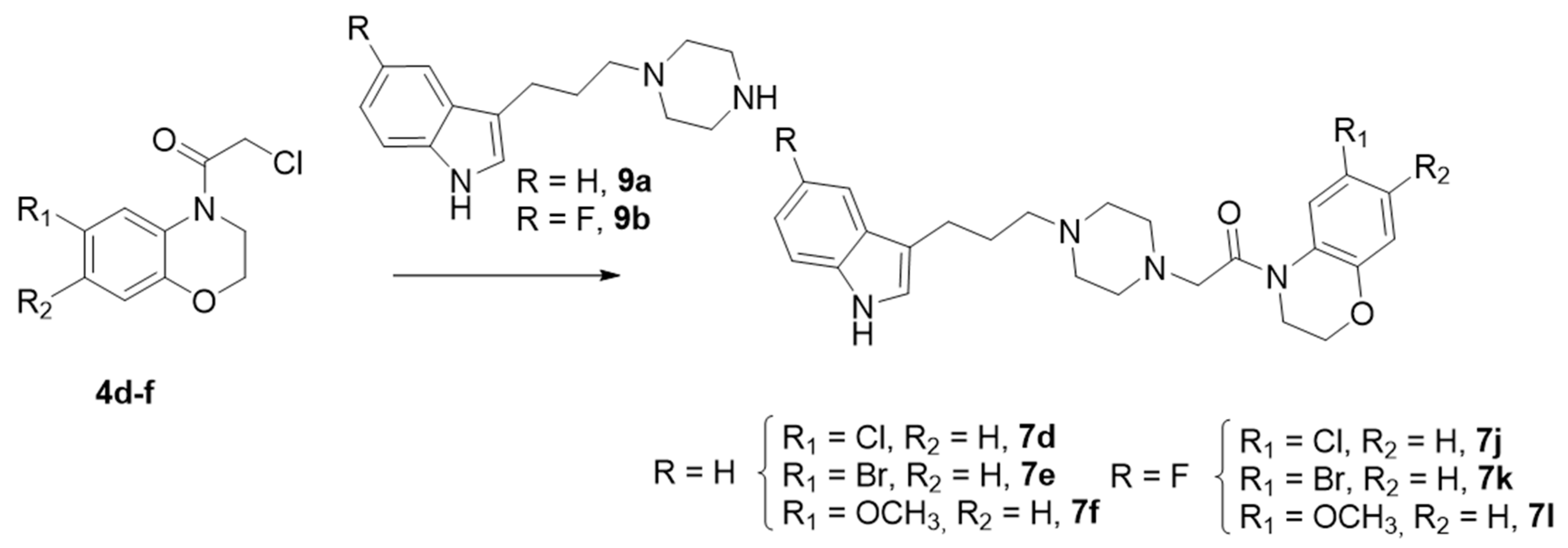
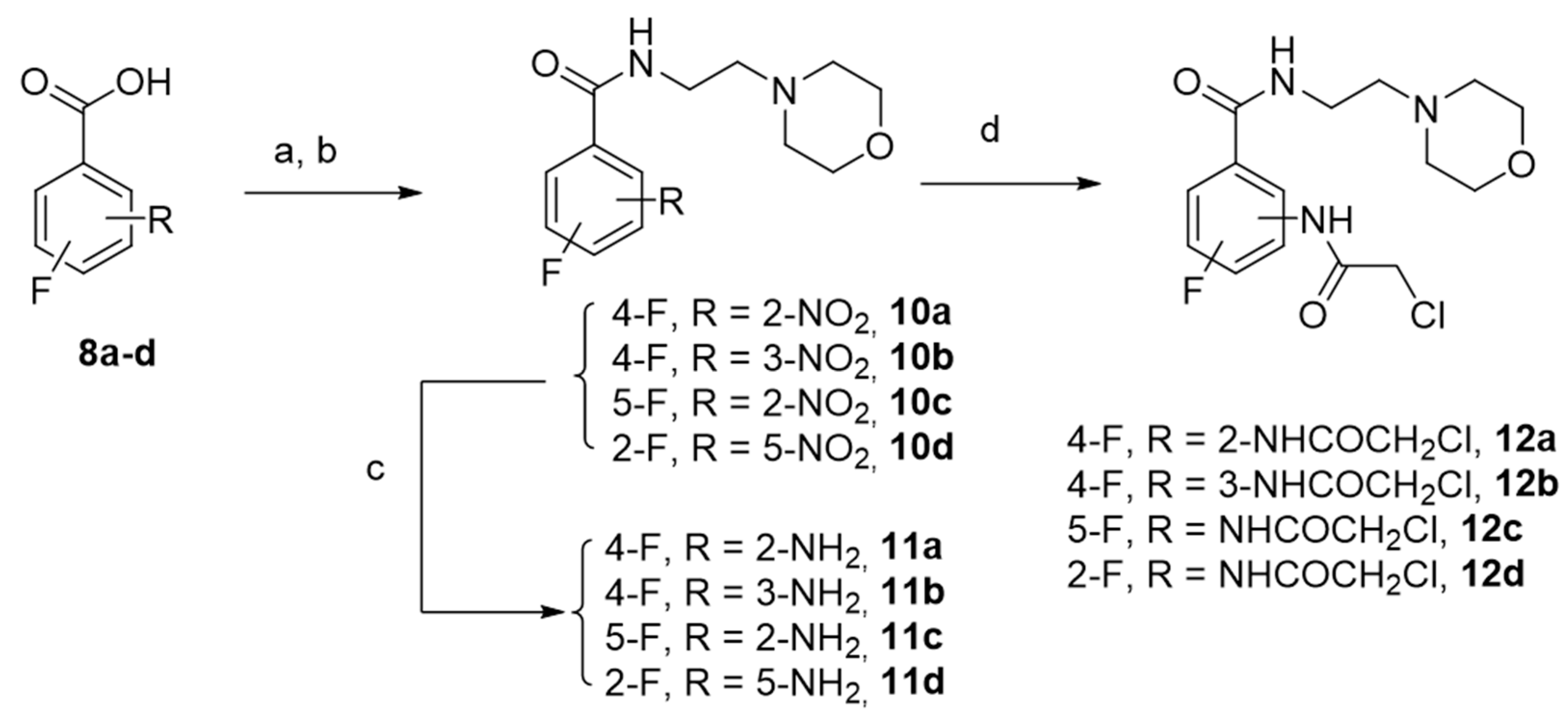
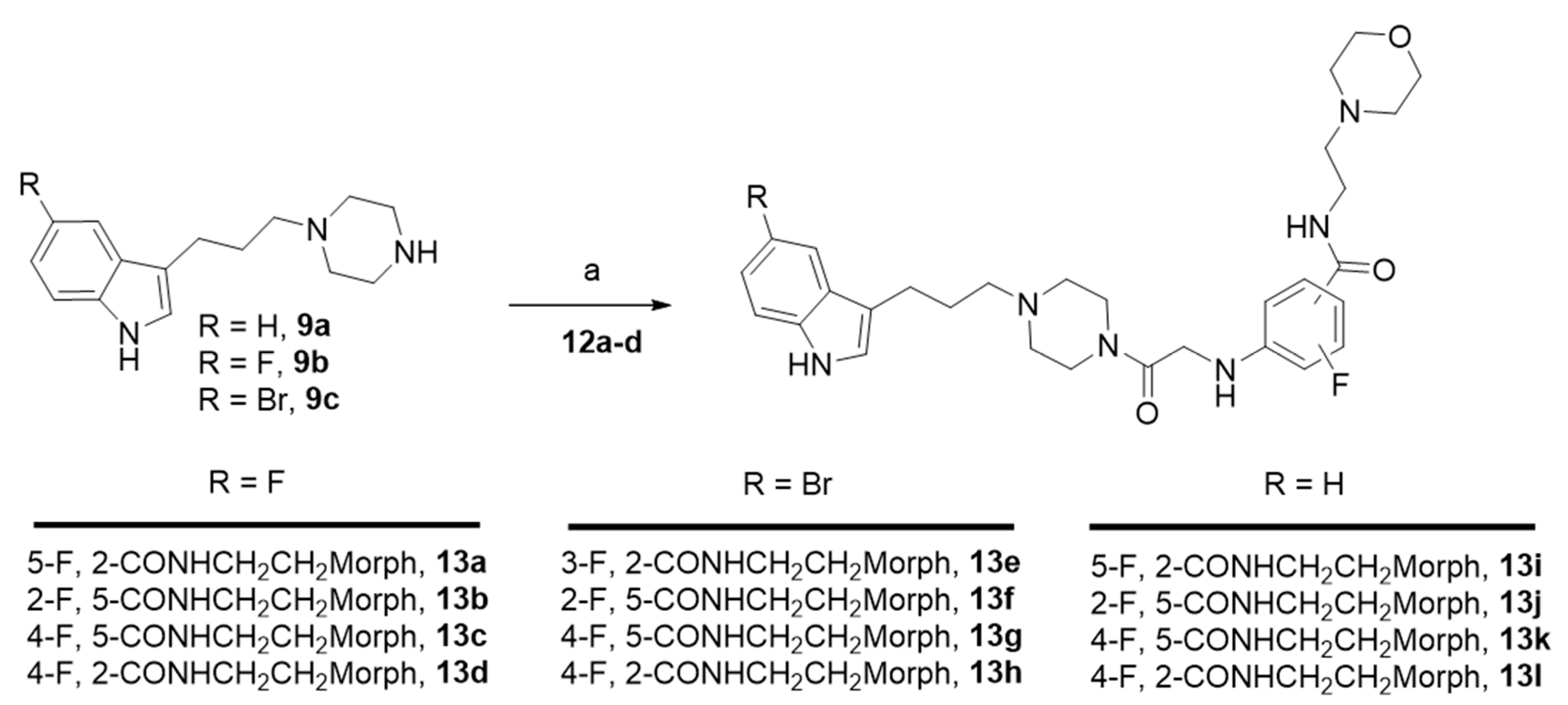
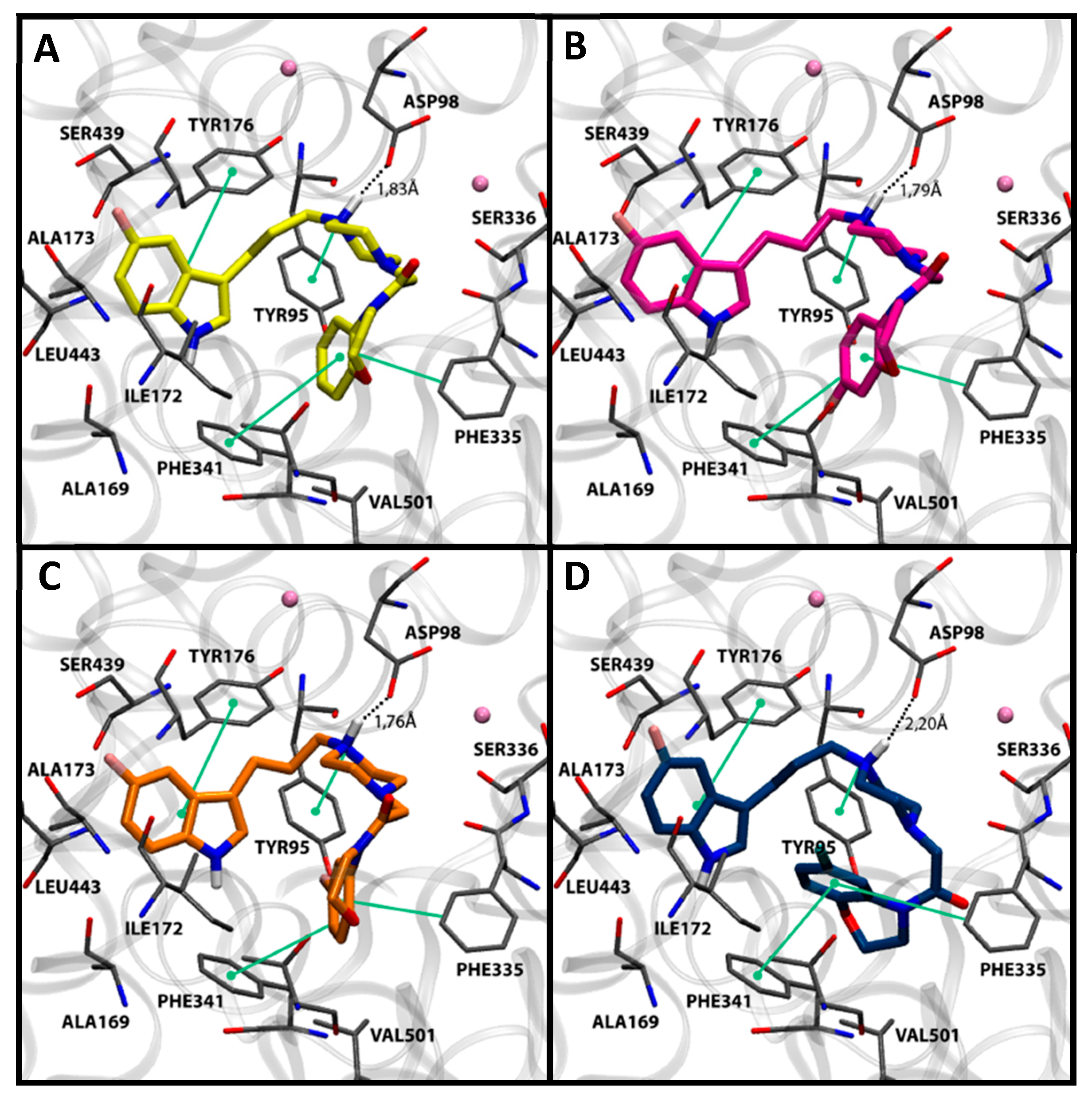

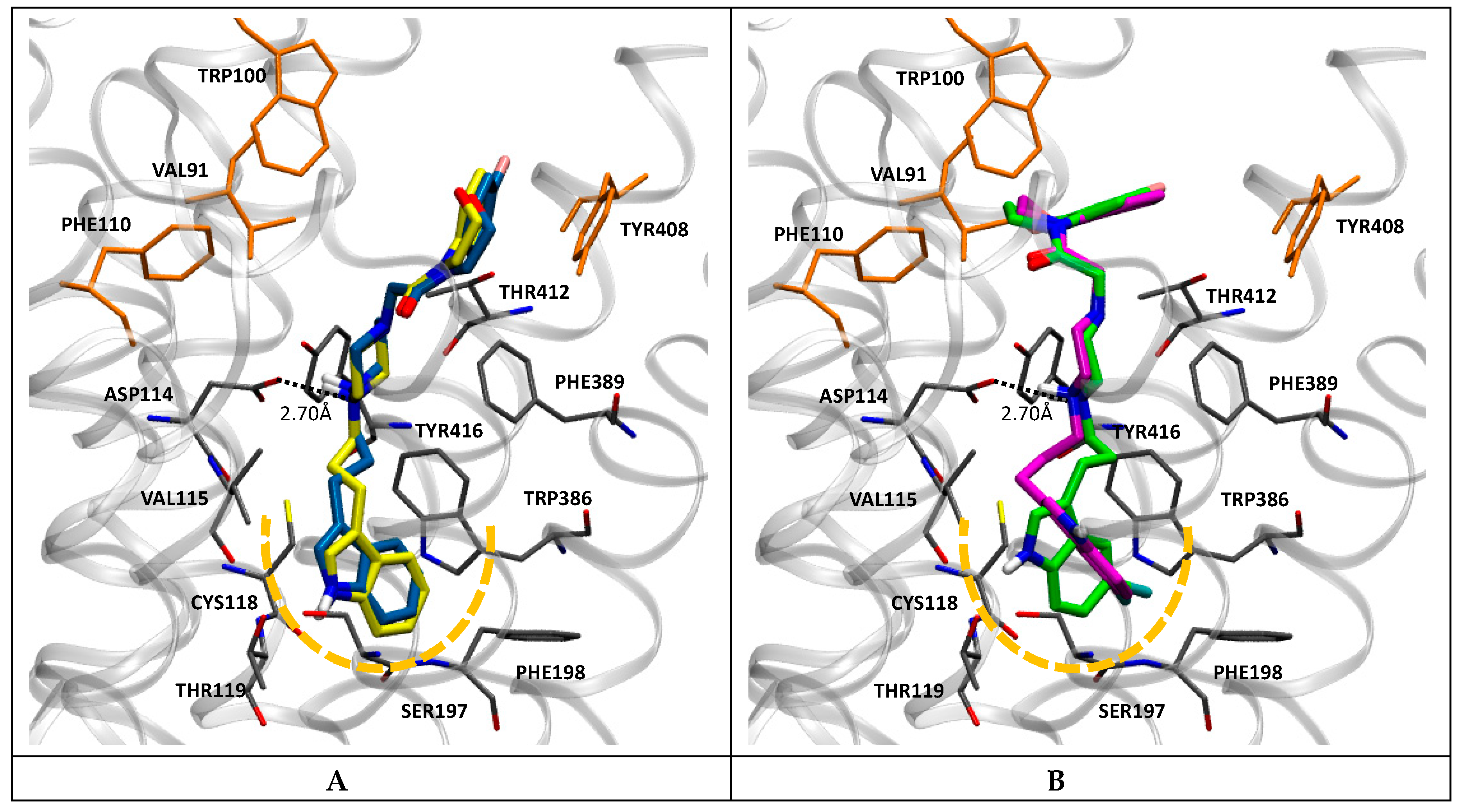

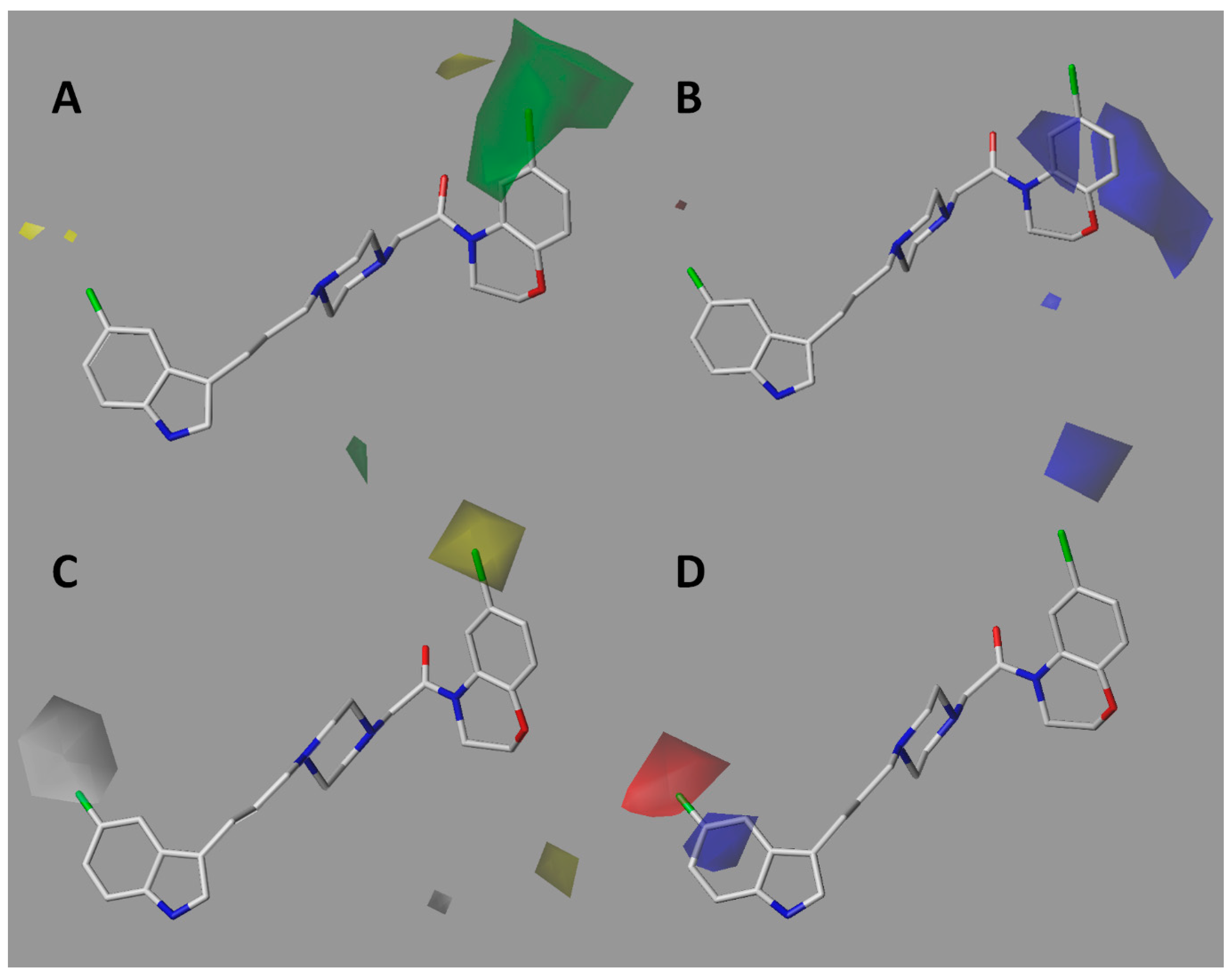
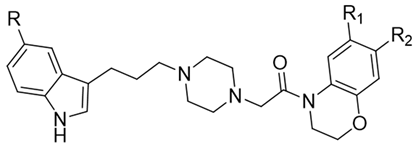
| Compound | R | R1 | R2 | SERT (nM) | D2 (nM) | % Inhibition MAO-A at 100 µM |
|---|---|---|---|---|---|---|
| Fluoxetine | - | - | - | 3.15 ± 0.32 | N.D. | N.D. |
| Haloperidol | - | - | - | N.D. | 3.88 ± 0.44 | N.D. |
| 7a | -H | -H | -H | 307.10 ± 30.46 | 4840 ± 68 | 27% |
| 7b | -H | -H | -F | 180.80 ± 19.97 | 4740 ± 131 | 43% |
| 7c | -H | -F | -H | 68.78 ± 1.02 | 2387 ± 163 | 40% |
| 7d | -H | -Cl | -H | 81.39 ± 4.97 | 1265 ± 182 | 18% |
| 7e | -H | -Br | -H | 36.57 ± 0.55 | 910 ± 263 | 38% |
| 7f | -H | -OCH3 | -H | 412.20 ± 57.86 | 4407 ± 647 | 58% |
| 7g | -F | -H | -H | 9.63 ± 0.31 | 2315 ± 64 | 41% |
| 7h | -F | -H | -F | 7.61 ± 0.02 | 2317 ± 163 | 0% |
| 7i | -F | -F | -H | 7.51 ± 0.12 | 1681 ± 79 | 0% |
| 7j | -F | -Cl | -H | 12.30 ± 2.31 | 902 ± 4 | 20% |
| 7k | -F | -Br | -H | 5.63 ± 0.82 | 1041 ± 232 | 20% |
| 7l | -F | -OCH3 | -H | 12.60 ± 1.52 | 3322 ± 256 | 52% |
| 7m | -Br | -H | -H | 50.18 ± 2.47 | 593 ± 62 | 30% |
| 7n | -Br | -H | -F | 84.44 ± 2.03 | 307 ± 6 | 23% |
| 7o | -Br | -F | -H | 34.89 ± 0,32 | 1152 ± 227 | 26% |

| Compound | R | Position (Indolylpropyl Piperazineacetamide) | Position F | SERT (nM) | D2 (nM) | % Inhibition MAO-A at 100 µM |
|---|---|---|---|---|---|---|
| Fluoxetine | - | - | - | 3.15 ± 0.32 | N.D. | N.D. |
| Haloperidol | - | - | - | N.D. | 3.88 ± 0.44 | N.D. |
| 13a | F | 2 | 4 | 16.04 ± 0.21 | 5455 ± 25 | 19% |
| 13b | F | 3 | 4 | 23.78 ± 0.46 | 3100 ± 42 | 42% |
| 13c | F | 5 | 2 | 6.83 ± 0.19 | 592.60 ± 30.22 | 28% |
| 13d | F | 2 | 5 | 98.14 ± 1.24 | 9060 ± 29 | 30% |
| 13e | Br | 2 | 4 | 222.60 ± 16.44 | 5619 ± 31 | 39% |
| 13f | Br | 3 | 4 | 58.85 ± 1.14 | 1832 ± 33 | 39% |
| 13g | Br | 5 | 2 | 12.62 ± 0.42 | 765 ± 16 | 16% |
| 13h | Br | 2 | 5 | 199.60 ± 14.53 | 4700 ± 168 | 9.4% |
| 13i | H | 2 | 4 | 9945 ± 383 | 48910 ± 1279 | 23% |
| 13j | H | 3 | 4 | 109.90 ± 3.26 | 2339 ± 45 | 44% |
| 13k | H | 5 | 2 | 26.81 ± 0.91 | 4169 ± 335 | 34% |
| 13l | H | 2 | 5 | 52.16 ± 3.24 | 2000 ± 34 | 34% |
© 2020 by the authors. Licensee MDPI, Basel, Switzerland. This article is an open access article distributed under the terms and conditions of the Creative Commons Attribution (CC BY) license (http://creativecommons.org/licenses/by/4.0/).
Share and Cite
Cerda-Cavieres, C.; Quiroz, G.; Iturriaga-Vásquez, P.; Rodríguez-Lavado, J.; Alarcón-Espósito, J.; Saitz, C.; Pessoa-Mahana, C.D.; Chung, H.; Araya-Maturana, R.; Mella-Raipán, J.; et al. Synthesis, Docking, 3-D-Qsar, and Biological Assays of Novel Indole Derivatives Targeting Serotonin Transporter, Dopamine D2 Receptor, and Mao-A Enzyme: In the Pursuit for Potential Multitarget Directed Ligands. Molecules 2020, 25, 4614. https://doi.org/10.3390/molecules25204614
Cerda-Cavieres C, Quiroz G, Iturriaga-Vásquez P, Rodríguez-Lavado J, Alarcón-Espósito J, Saitz C, Pessoa-Mahana CD, Chung H, Araya-Maturana R, Mella-Raipán J, et al. Synthesis, Docking, 3-D-Qsar, and Biological Assays of Novel Indole Derivatives Targeting Serotonin Transporter, Dopamine D2 Receptor, and Mao-A Enzyme: In the Pursuit for Potential Multitarget Directed Ligands. Molecules. 2020; 25(20):4614. https://doi.org/10.3390/molecules25204614
Chicago/Turabian StyleCerda-Cavieres, Christopher, Gabriel Quiroz, Patricio Iturriaga-Vásquez, Julio Rodríguez-Lavado, Jazmín Alarcón-Espósito, Claudio Saitz, Carlos D. Pessoa-Mahana, Hery Chung, Ramiro Araya-Maturana, Jaime Mella-Raipán, and et al. 2020. "Synthesis, Docking, 3-D-Qsar, and Biological Assays of Novel Indole Derivatives Targeting Serotonin Transporter, Dopamine D2 Receptor, and Mao-A Enzyme: In the Pursuit for Potential Multitarget Directed Ligands" Molecules 25, no. 20: 4614. https://doi.org/10.3390/molecules25204614







